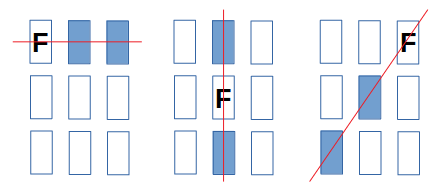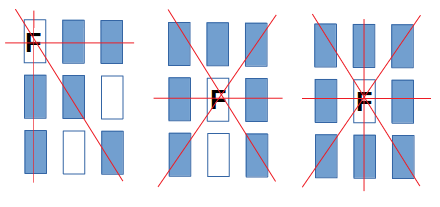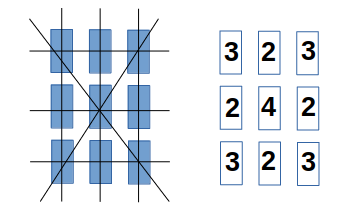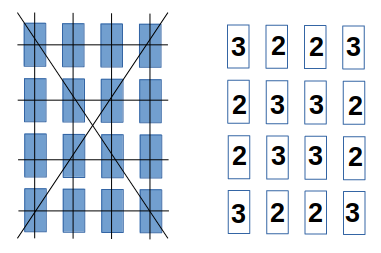Nice Dice and Super Nice Dice -- Original Dice Games
Invented by Howard Fosdick (V 1.1) © BestFreeNewGames.com
Here are two fast, easy dice games that still require a bit of thought. We'll introduce the basic game, then describe a more sophisticated version that offers greater scope for scoring and strategy.
Nice Dice
For: 2 or 3 players. Or 4 players in two partnerships.
Equipment: Two dice and one deck of playing cards. To create the card deck you'll use for this game, take a standard 52 card pack and remove all cards above the 8. So you'll end up with 32 cards, ranking Ace-2-3-4-5-6-7-8. The Ace has a value of 1 in this game.
A cribbage board to keep track of scoring is optional but enhances the game.
Objective: To score points by completing rows in a Tic-Tac-Toe board composed of playing cards.
Set Up: Roll to see who goes first. (After the first round, whoever is behind goes first.)
Then deal out 9 cards face up in this pattern on the table:

Play: In his turn, each player roles the two dice.
He then turns over one card in the layout whose number matches either of the numbers he has thrown, or one card that matches their sum.
For example, a role of 2-3 can be considered as either a 2, 3, or 5. The player must turn face down a card that is either a 2, 3, or 5.
The player is required to turn over a card if possible. If he can not, he turns no card face down, and it becomes his opponent's turn.
If the player throws doubles, he turns over a card (if possible), and takes another turn. This can continue for as long as he rolls doubles.
Scoring: Players score points by completing rows of face down cards in the layout.
Completing a single row in any direction -- vertical, horizontal, or diagonal -- scores 1 point. In these examples, the letter "F" marks the card flipped over to score the point:

Completing two rows at once scores 1 point for each completed row, or a total of 2 points for the play. These examples show how a player scores 2 points by flipping over the card marked by the "F":

The next two examples below illustrate 3 point plays. The example on the right shows the sole possible 4 point play in the game:

Winning: The player with the most total points after all cards have been flipped over wins the Round. When two play, the person who first reaches a total of 13 points across Rounds wins the Game. When three play, the first to total 10 points wins Game.
Playing Tips: While luck plays a big role in this game, you can increase your chances for success by knowing and playing the odds.
If you go first, your best move may be to flip the center card if you can. If your opponent flips over a single card in his turn, he will be forced to give you a set-up for scoring the first point.
Defence is as important as offence. Don't just look where you can score, look where you can score while leaving your opponent with the worst possible options.
7's and 8's are harder to role than the numbers 1 through 6 because they require a correct sum of both die. If cards showing 7's or 8's are left to the end of the game, it's not unusual to experience a flurry of rolls before someone finally flips those cards. The player who is behind should hang in and strategise for a dramatic late win or tie.
The last few cards will score, often with more than one point per play. It's not unusual for the last flip or two to determine the winner, which makes for an exciting ending.
For convenience, we keep score on a cribbage board. This transforms the game into a race and increases excitement because competitors can see their relative positions at a glance.
Analysis: The left-hand diagram below shows all possible paths to scoring points. Exactly 8 points will be scored per round, since each row will be completed by round's end.
The layout positions have different scoring potentials under different conditions. The diagram below on the right shows the maximum number of points one can score in each position by flipping a card there under optimal conditions:

Variation -- Increase the size of the board to a square of 4 cards by 4 cards (instead of 3 by 3). 10 points will be scored per round.
Super Nice Dice
This version of Nice Dice presents greater complexity and offers more opportunities to score.
Rules are the same as in Nice Dice except:
2. Use the entire deck of 52 cards. From low to high, the cards rank: 1 (ace), 2, 3, 4, 5, 6, 7, 8, 9, 10, 11 (jack), 12 (queen), 13 (king).
3. Each player rolls 3 dice (instead of 2). Players can use any single die, or any additive combination of either two or three dice, as their number for the layout. For example, for a roll of 1-3-6, valid plays are: 1, 3, 6, 4, 7, 9, and 10. Another example: for a roll of 1-2-3, valid plays are: 1, 2, 3, 4, 5, and 6.
4. If a player rolls doubles (a pair), he gets exactly one extra roll after his initial roll. If he rolls a triplet (3-of-a-kind), he gets exactly two extra rolls. Unlike Nice Dice, a player can not continue his turn indefinitely by repeatedly rolling doubles.
Analysis: The lefthand diagram below illustrates all rows that will be completed during the course of a game. 10 points total will be scored per round.
The layout positions have different scoring potentials under different conditions. The diagram on the right shows the maximum number of points one can score in each position by flipping a card there under optimal conditions:

Flipping the last few cards will score. The player who is behind often has a chance for a tie or even a win if he dominates late in the round.
Variation -- Some prefer to play without the Kings, as this avoids having to roll for the less-likely 13's.
License: Feel free to print, copy, and distribute these rules, so long as you retain this paragraph. Invented by Howard Fosdick © 2024, distributed under Creative Commons License BY-ND.